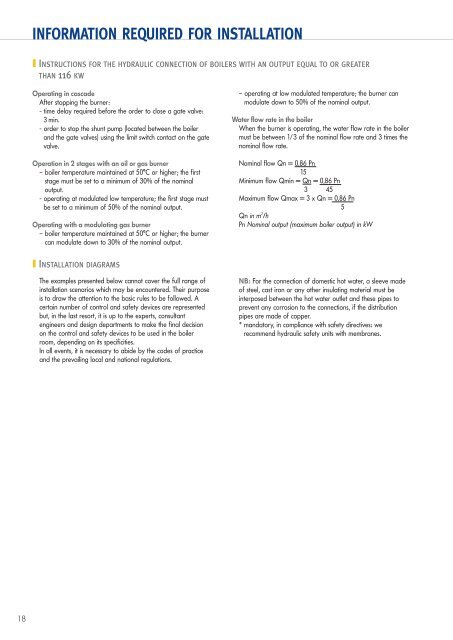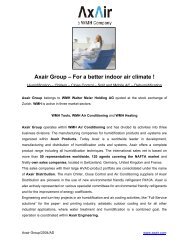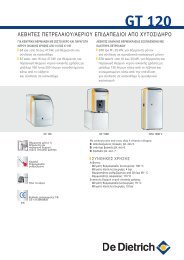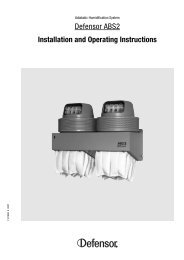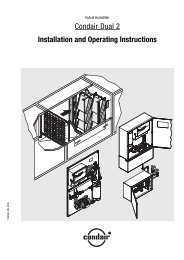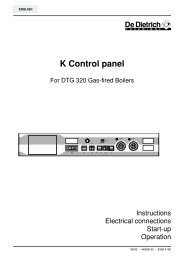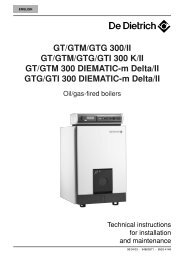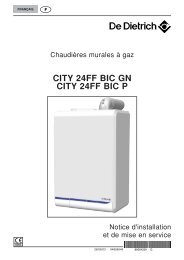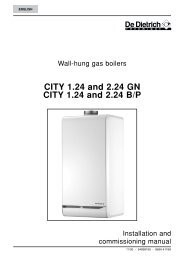the various control panels
the various control panels
the various control panels
You also want an ePaper? Increase the reach of your titles
YUMPU automatically turns print PDFs into web optimized ePapers that Google loves.
INFORMATION REQUIRED FOR INSTALLATION<br />
INSTRUCTIONS FOR THE HYDRAULIC CONNECTION OF BOILERS WITH AN OUTPUT EQUAL TO OR GREATER<br />
THAN 116 KW<br />
Operating in cascade<br />
After stopping <strong>the</strong> burner:<br />
- time delay required before <strong>the</strong> order to close a gate valve:<br />
3 min.<br />
- order to stop <strong>the</strong> shunt pump (located between <strong>the</strong> boiler<br />
and <strong>the</strong> gate valves) using <strong>the</strong> limit switch contact on <strong>the</strong> gate<br />
valve.<br />
Operation in 2 stages with an oil or gas burner<br />
– boiler temperature maintained at 50°C or higher; <strong>the</strong> first<br />
stage must be set to a minimum of 30% of <strong>the</strong> nominal<br />
output.<br />
- operating at modulated low temperature; <strong>the</strong> first stage must<br />
be set to a minimum of 50% of <strong>the</strong> nominal output.<br />
Operating with a modulating gas burner<br />
– boiler temperature maintained at 50°C or higher; <strong>the</strong> burner<br />
can modulate down to 30% of <strong>the</strong> nominal output.<br />
– operating at low modulated temperature; <strong>the</strong> burner can<br />
modulate down to 50% of <strong>the</strong> nominal output.<br />
Water flow rate in <strong>the</strong> boiler<br />
When <strong>the</strong> burner is operating, <strong>the</strong> water flow rate in <strong>the</strong> boiler<br />
must be between 1/3 of <strong>the</strong> nominal flow rate and 3 times <strong>the</strong><br />
nominal flow rate.<br />
Nominal flow Qn = 0,86 Pn<br />
15<br />
Minimum flow Qmin = Qn = 0,86 Pn<br />
3 45<br />
Maximum flow Qmax = 3 x Qn = 0,86 Pn<br />
5<br />
Qn in m 3 /h<br />
Pn Nominal output (maximum boiler output) in kW<br />
INSTALLATION DIAGRAMS<br />
The examples presented below cannot cover <strong>the</strong> full range of<br />
installation scenarios which may be encountered. Their purpose<br />
is to draw <strong>the</strong> attention to <strong>the</strong> basic rules to be followed. A<br />
certain number of <strong>control</strong> and safety devices are represented<br />
but, in <strong>the</strong> last resort, it is up to <strong>the</strong> experts, consultant<br />
engineers and design departments to make <strong>the</strong> final decision<br />
on <strong>the</strong> <strong>control</strong> and safety devices to be used in <strong>the</strong> boiler<br />
room, depending on its specificities.<br />
In all events, it is necessary to abide by <strong>the</strong> codes of practice<br />
and <strong>the</strong> prevailing local and national regulations.<br />
NB: For <strong>the</strong> connection of domestic hot water, a sleeve made<br />
of steel, cast iron or any o<strong>the</strong>r insulating material must be<br />
interposed between <strong>the</strong> hot water outlet and <strong>the</strong>se pipes to<br />
prevent any corrosion to <strong>the</strong> connections, if <strong>the</strong> distribution<br />
pipes are made of copper.<br />
* mandatory, in compliance with safety directives: we<br />
recommend hydraulic safety units with membranes.<br />
18


